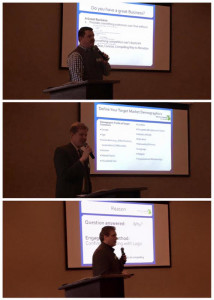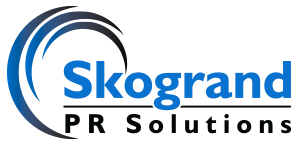
Ryan Berkness, Brant Skogrand, APR, MBC, and Larry Davis speak on how to market a business at the Small Business Advisory Board meeting on March 9, 2016.
At this month’s Small Business Advisory Board (SBAB) luncheon more than 80 industry professionals gathered for an afternoon dedicated to discussing effective marketing. Speakers Ryan Berkness of PR Caffeine: Home of EspreSEO, Larry Davis of Fox Tracks Marketing Solutions, and our very own Brant Skogrand of Skogrand PR Solutions presented on the five stages of effective marketing. Their presentation posed a series of questions and then provided direction for attaining effective marketing.
An overview of the presentation on small business marketing tips is outlined here. Each of the five stages contains a question, an engagement method and examples of applicable traditional and digital tools. The traditional tools abide by the law of persuasion and the digital tools adhere to the law of attraction.
Stage 1: Awareness
In this stage you answer the question: What? What is your product and/or service and what sets it apart from the rest?
- Engagement method: Feeling. This requires that your message is conscious, memorable and repetitious.
- Traditional tools: Print, newspaper, television, radio, billboards, public relations, word of mouth and conferences.
- Digital tools: Social media, email marketing and SEO.
Stage 2: Search
This stage is all about answering the question: Where? Where will customers find out about your product and/or service?
- Engagement method: Logic. This requires that you be present, available and easily able to be found.
- Traditional tools: Yellow Pages, directories, chambers of commerce, networking, associations, business cards, Rolodex, and storefronts.
- Digital tools: SEO, Yelp, online directories and websites.
Stage 3: Reason
In this stage you answer the question: Why? Why is your product and/or service necessary and important? Why should the customer pursue your products and/or services instead of your competitors?
- Engagement method: Confirming feeling with logic. This requires that you be clear, concise and compelling.
- Traditional tools: Brochures, sales funnel and sales calls.
- Digital tools: Website, reviews, social media and SEO.
Stage 4: Cultivate
This stage is all about answering the question: When? When and how quickly will customers decide to purchase your product and/or service?
- Engagement method: Urgency and/or fear. This requires that you be urgent, solve a crisis or offer a sense of fear and then peace.
- Traditional tools: High-pressure sales, “buy now, pay later” promotions and sales associates.
- Digital tools: Free trial promotions, email marketing, marketing automation, wish lists and cart abandonment marketing.
Stage 5: Purchase
In this stage you answer the question: How? How will your customers purchase your product and/or service?
- Engagement method: Satisfaction. This requires that your purchase process be fast, easy and simple.
- Traditional tools: Invoices, cash transactions, storefront shopping, personal sales and telephone sales.
- Digital tools: Website shopping, electronic point-of-purchase within the store, personal sales or telephone sales.
Every month the SBAB hosts a luncheon dedicated to helping small business owners share insights and advice. Each luncheon tackles a new industry topic and provides an opportunity for networking with local business owners. A special thanks to this month’s luncheon sponsor Steve Callender of Effective Learning for Growth. To learn more about the Small Business Advisory Board you can browse the website here. For a list of upcoming luncheons and topics I invite you to view the SBAB calendar.
